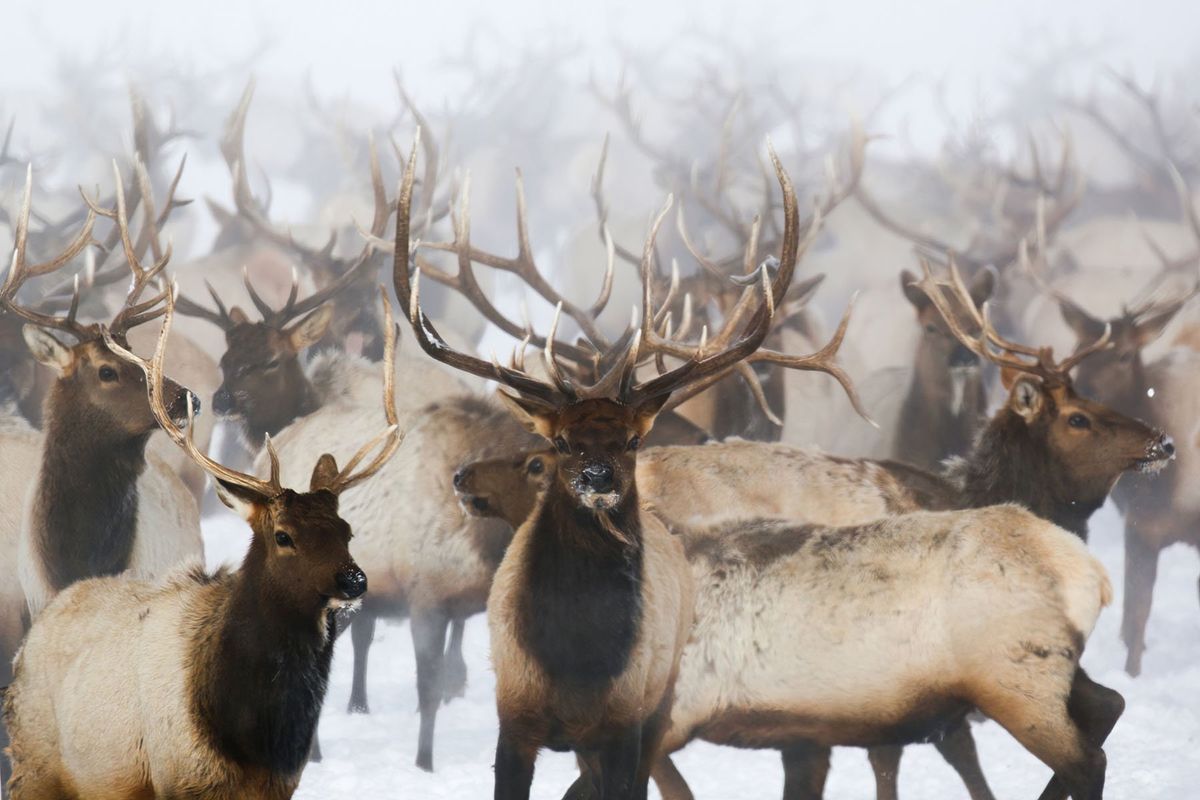Wyoming elk feedground draft management plan out for public comment

BILLINGS – Feeding western Wyoming’s elk herds began in the winter of 1909-10 with a simple premise: to try and keep the animals from starving to death.
Although it started with noble conservation intentions, the program eventually expanded to reduce private property damage, such as elk raiding ranchers’ haystacks.
Now more than 100 years later, congregating elk on winter feedgrounds is seen as a threat to the very animals that conservationists were originally set on saving. That’s because it is now known that concentrating wildlife enables the spread of a variety of deadly contagious diseases that can affect not only elk, but also other ungulates such as deer, bison and even cattle.
Draft planIn an attempt to address concerns over disease spread, the Wyoming Game and Fish Department (WGFD) has released a Draft Wyoming Elk Feedgrounds Management Plan for public review and comment. The process began three years ago.
“This plan is intended to chart a long-range path for feedground management,” said Brian Nesvik, WGFD director, in the draft plan. “It is not a feedground closure plan. It is a road map to identify a responsible set of actions that will guide the manner in which all involved make decisions to deal with current and emerging challenges and conflicts.”
Acknowledging the 22 feedgrounds in western Wyoming’s Teton, Lincoln and Sublette counties are a source of disease transmission, the Wyoming Game and Fish Department has laid out its ideas to try and stem the problems that arise when roughly 15,000 elk congregate in winter. The proposals range from graveling feedgrounds to halt the animals’ contact with possibly infected soil, to spreading feed lines out, acquiring more winter habitat and improving existing public habitat. Some of these techniques have already been implemented, such as spreading feeding areas out.
Now the public has an opportunity to weigh in. Comments will be taken through Sept. 10. Once those ideas have been considered and a public steering committee has weighed in, the agency will present the plan to the Wyoming Game and Fish Commission at its Nov. 14-15 meeting in Cody.
FMAPsCentral to WGFD’s proposal is the development of feedground management plans, which would require additional personnel and equipment. No dollar figure was attached to the draft plan, but it would likely be more than the $2.7 million spent feeding elk in 2022.
At stake in this entire process is a significant source of state income. Elk hunting license sales generated $11.47 million in 2021. Wildlife-related outfitter and tourism industries account for close to $800 million in expenditures and thousands of Wyoming jobs.
“The overall goal of this plan is to encourage managers to continue to explore opportunities for elk to winter away from feedgrounds by increasing tolerance for elk on private, state, and federal lands while reducing reliance on supplemental feeding,” the draft plan stated.
The hard part will be figuring out how to get the elk to spread out and become less reliant on supplemental feeding while not affecting adjoining private landowners.
DiseaseShould the department fail to wean elk off the feedgrounds, scientists have predicted dire consequences. Brucellosis is spread by contact with birthing material and can cause pregnant ungulates to abort. Keeping elk away from cattle is seen as the primary way to prevent transmission to livestock.
Necrobacillosis is a bacteria that has infected elk on the feedgrounds since the 1920s, causing tissue damage that can lead to death. The infection can also cause lameness and difficulty eating, as it often infects animals through their feet and mouth.
Chronic wasting disease (CWD) is an always fatal infection that has spread across most of Wyoming and into Montana. Not just a regional problem, CWD has been identified in 31 states, four Canadian provinces, Finland, Norway, South Korea and Sweden. It is spread through an animal’s contact with an infected animal’s bodily fluids and is believed to survive in the soil and possibly be taken in by plants. Misfolded proteins called prions are the infectious agents, unlike a virus or bacteria, and are extremely resistant to being deactivated.
A 2020 study using the Pinedale elk herd predicted that, “continuation of feeding, with the current elk population management, could see (CWD) prevalence exceed 75% and would cost the Pinedale area $19 million over 20 years once CWD is detected in the study area.”
In response to a possible CWD infection at a feedground, the department has outlined plans, including possibly reducing elk herds and evaluating closure of the feedground.
“If CWD prevalence in the respective herd unit reaches 7%, the Department shall evaluate options and strive to reduce feedground densities by 10% through population reductions, feeding modifications, or winter distributional shifts within one year,” the draft plan stated. “If the CWD prevalence in the respective herd unit reaches or exceeds 10% for three consecutive years, the Department shall consider and evaluate the need to begin the process of closing the feedground as soon as possible.”
Although the consumption of wildlife infected with CWD is not known to affect humans, the Centers for Disease Control and Prevention advises against eating infected animals. Wyoming and Montana have enacted programs for hunters to have their game animals tested for the disease. Infected animals may not appear sick when killed.
PerspectiveIt’s widely recognized that feeding wildlife can be detrimental to their survival. Montana outlaws the practice. Some wildlife officials in the past have blamed the Wyoming feedgrounds for helping spread disease to animals that migrate from Wyoming, through Yellowstone National Park and into Idaho and Montana.
Public meetings have already been held across western Wyoming where the plan has met opposition from livestock groups for its proposal to seek more private lands for elk to winter on, as well as criticism from conservationists because feedgrounds would continue to exist. Conservation groups are compiling more detailed responses to the draft plan but have not yet released any information.
To read the plan, or to comment: wgfd.wyo.gov/Regional-Offices/Jackson-Region/Jackson-Region-News/G-F-Releases-Draft-Elk-Feedgrounds-Plan-for-Public.